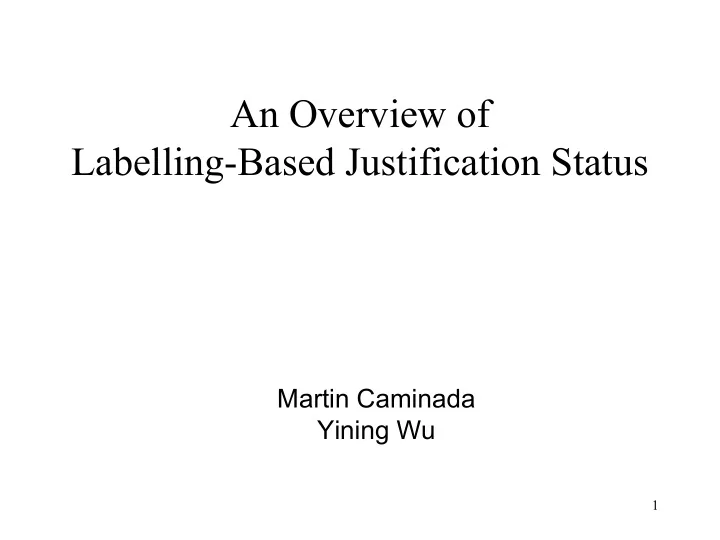

An Overview of Labelling-Based Justification Status Martin Caminada Yining Wu 1 1
Preliminaries • Argumentation framework : graph (Ar, att) in which – the nodes (Ar) represent a given set of arguments, – the arrows (att) represent the attack relation. • A labelling is a function L ab: Ar → {in, out, undec}. • A complete labelling is a labelling s.t. For each argument A, – A is labelled in iff all its attackers are labelling out. – A is labelled out iff it has an attacker that is labelled in. eg. in a gun fight You survive iff al your attackers are killed. You get killed iff at least one attacker remains alive. 2 2
An Example B A C D 3
An Example B A C D 4
An Example B A C D 5
An Example B A C D 6
Justification Status Justification status: the set of labels that can be assigned to an argument by the complete labellings. B A B B A A C C C D D D 7
Justification Status Justification status: the set of labels that can be assigned to an argument by the complete labellings. B A B B A A C C C D D D 8
9 9
10 10
11 11
12 12
13 13
Justification Status of Conclusions L • each argument A has a conclusion Conc(A) ∈ • a conclusion labelling is a function ConcLab: L → {in, out, undec} • Given an argument labelling ArgLab, we define the associated conclusion labelling ConcLab s.t. ConcLab(c) is the label of the “best” argument for c (or out, if no argument for c exists) 14
Justification Status of Conclusions L • each argument A has a conclusion Conc(A) ∈ • a conclusion labelling is a function ConcLab: L → {in, out, undec} • Given an argument labelling ArgLab, we define the associated conclusion labelling ConcLab s.t. ConcLab(c) = max({ArgLab(A) | Conc(A)=c} ∪ {out}) 15
Justification Status of Conclusions L • each argument A has a conclusion Conc(A) ∈ • a conclusion labelling is a function ConcLab: L → {in, out, undec} • Given a complete argument labelling ArgLab, we define the associated complete conclusion labelling ConcLab s.t. ConcLab(c) = max({ArgLab(A) | Conc(A)=c} ∪ {out}) JS (c) = {ConcLab(c) | ConcLab is a complete conclusion labelling} • 16
Example:Dealing with Floating Conclusions • Brygt Rykkje is Dutch because he was born in Holland • Brygt Rykkje is Norwegian because he has a Norwegian name • Brygt Rykkje likes ice skating because he is Norwegian • Brygt Rykkje likes ice skating because he is Dutch 17
Example:Dealing with Floating Conclusions • John says the suspect killed the victim by stabbing him • Bob says the suspect killed the victim by shooting him • The suspect killed the victim, because Bob says the suspect killed the victim by shooting him • The suspect killed the victim, because John says the suspect killed the victim by stabbing him 18
Example:Dealing with Floating Conclusions ArgLab 1 = ({A, D}, {B,C}, ∅ ) D C ConcLab 1 = ({a, e}, {b}, ∅ ) ArgLab 2 = ({B,C}, {A,D}, ∅ ) B A ConcLab 2 = ({b, e}, {a}, ∅ ) Conc(A) = a ArgLab 3 = ( ∅ , ∅ , {A,B,C,D}) Conc(B) = b Conc(C) = e ConcLab 3 = ( ∅ , ∅ , {a,b,e}) Conc(D) = e JS (e) = {in, undec} (weak accept) 19
Labelling-Based JS: • provides levels of justification based on standard AFs (so no probabilities or other numerical add-ons) • provides a more refined status than the usual extension based approached (e.g. grounded or credulous preferred) • can easily be computed (based on existing proof procedures for grounded and preferred) • can be applied to arguments as well as to conclusions (floating conclusions become weakly accepted) 20 20
Literature • Yining Wu and Martin Caminada A Labelling-Based Justification Status of Arguments Studies in Logic 3(4):12-29 (2010) • Wolfgang Dvořák On the Complexity of Computing the Justification Status of an Argument TAFA post proceedings, pages 32-49 (2012) 21 21
Recommend
More recommend